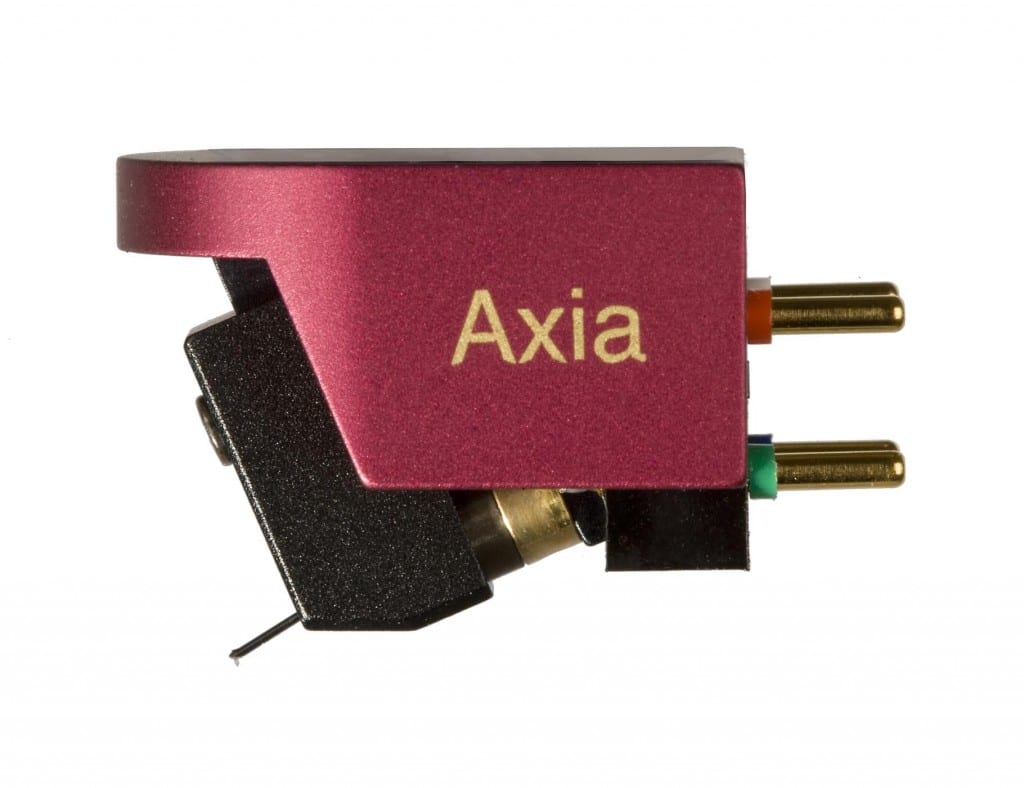Janine Elliot takes the £1375 Transfiguration Axia S cartridge for a spin.
I have spent many lonely and sad evenings setting up my vinyl over the years, from my original ceramic (yes, remember them!) cartridges, a few embarrassing magnetic Shure cartridges for my Garrard SP25/iii, to my semi-grown up players with Philips 400, Ortofon VMS20E, Shure V15iii and iv, right the way to my present Kontrapunkt b. To be given a cartridge as different from my Ortofon as chalk is from cheese was a breath of fresh air and enabled me to have an open-minded view in my assessment.
SET UP
To say this cartridge was easy to set up was an understatement. The thick aluminium body with parallel sides was a gift for even the fumbling vinyl fan. The only slight adjustment I needed to make once set up was to get the stylus angle (rake) just right (around 30 degrees) in order to get optimum stereo width and so that the sound didn’t sound ‘narrowed’ between the speakers, which it did sound initially. The instruction sheet suggests you change the angle so that the stylus doesn’t sit vertically into the grove but “points back slightly”. I also made slight setting adjustments on my Manley Steelhead phonostage so that load impedance was around 20ohms. In terms of weight this cartridge likes to be set up at around 1.8 – 2g, and I ended up with 2.1g only to allow for the trough/paddle combination of my Townshend Rock7 turntable. Interestingly, my Kontrapunkt is suggested at 2.2 grams but worked better on this turntable at a mere 1.8g.
I have eagerly observed the Transfiguration brand over the years, designed by Immutable Music’s Seiji Yoshioka. I have particularly liked their unique and clever yoke-free design (more of that in a bit) and with family members with names like Pheonix, Temper and Spirit, they could well have been the names of my own children. All used the patented ‘yokeless’ double-ring magnet design, and their present generation continue this tradition. The latest models in the range, Axia S, Pheonix S and Proteus, continue the trend of lovely names. The word ‘Axia’ translates from Greek word αξια meaning “value, capable, merit, worth and worthiness” and this model certainly lives up to its name. The Axia S forms the lowest priced, but for me the better looking, of three moving-coil cartridges from Transfiguration, the review sample being imported into the UK by Decent Audio. Retailing at £1375 it ain’t cheap, but bearing in mind it is joined by the Phoenix S, priced at £1995 and the £2995 Proteus, this is an exceptionally good value model given its credentials. Like its family members, has a body made of machined, solid aluminium. Within this are two magnets arranged in a yokeless, double ring configuration which results in the 5N silver coils being positioned efficiently inside the magnets. This model has a Samarium cobalt magnet at the front and a neodymium one at the back, whereas the other models have neodymium at both ends. Neodymium rare-earth magnets first appeared around the 1980s, and have the strongest magnetism, though interestingly Samarium cobalt is the more expensive to buy. The unusually short cantilever is made of 0.3mm diameter solid boron and is tipped with a 3 x 30µm Ogura PA stylus (seen in a number of cartridges from other manufacturers).
After a very short set-up period I could begin to listen. I was lost for words in the opening track of side D of the “The Division Bell” re-master, (Pink Floyd). The aptly titled track ‘Lost for Words’ gave me an insight into how good this cartridge was going to be. The opening musique concrete gave way to a guitar trio with footsteps that was oh such fun. Or was it my feet tapping. From the lowest bass rhythm through the mid warmth of David Gilmour’s voice right up to the tight metal strings on the guitars the detail was all there. Adjusting the rake angle until it was just right allowed the music to open up into as 3-dimentional a sound that vinyl can produce. Vinyl is just so good! The sound was very tight, very musical and not in the slightest hinting at being in any difficulty or hurry, with an excellent stereo width and depth of sound, and a good dynamic range helped by the Neodymium back end. The bells and piano riffs in the final track were as clear as the best I have ever heard it, and the thumping marcato in the drums and bass even surprised me by its strength. I was lucky that this review sample didn’t need a break-in period, and I could listen in a way that I hadn’t before with my Ortofon Kontrapunkt. Where the Kontrapunkt is an aging but great cartridge I felt the Axia opened up the music with energy and panache, more than my stalwart needle. What I was struck by was the amount of confidence and dynamism when compared to the more clinical Ortofon. I did, however, feel at times that this extra energy and detail could make the sound very slightly ‘cluttered’.
With that in mind I played some intricate classical music from Manuel de Falla, his “Love The Magician” (LSO, Geoffrey Simon, Chandos) which brought out a heaped portion of magic from the oboes, piano and strings and the vocals. De Falla is a complicated composer mixing everything in short spaces, whether it be different textures, timbres or techniques all mixed in a pint-pot size. To play this work well I would need to have a good needle, and this did it well, from the col legno on the strings (using the bow stick to hit the strings, rather than the horse hair) to the bursts of the horns or trumpets, to the empty spaces in between. This work has it all, and the Axia S sounded much more at home in this work than in the Pink Floyd. Depth of field was very musical and this cartridge sounded very much at its best. With such a variety of instruments and changes in depth of music this cartridge played it all so very well. Playing my trusty old Ortofon Test record, the Axia S was at ease with all but the most cruel setting on the vertical and lateral tracking tests, perhaps aided somewhat by the Townshend trough and paddle system. Moppin and Boppin (T.Walter/Carter/Cirkeby) on side B was the best I had heard it played for years. Polka from the Bolt (Shostakovich) gave a much wider and deeper soundstage from the pianissimo’s to the sforzando’s than on other cartridges I have reviewed.
Prokofiev Cinderella (LSO, Andre Previn, EMI) allowed me to get a really good insight into the warmth and musicality of the middle instruments. I could hear the First and Second violins as I would if I was conducting this underrated work from the ballet suite supremo.
Miles Davis ‘Bitches Brew’ re-master is a bitch to play on any spinner, particularly the title track on side B. Occasionally I did feel the Axia S could over complicate the sound at times. However, this is by no means a complaint, rather a characteristic of the sound.
CONCLUSION
This cartridge is quite some wolf in (red) sheep’s clothing. £1375 certainly isn’t cheap, but the Axia S is one hell of a musical player, not sheepish in trying to extrapolate the best from the music, and more than justifies it price when comparing with others at this price point. It worked well with all the music I played, only at times showing me slightly that I could do better, which I guess is why you might want to spend more on the Pheonix S or Proteus. I liked this model a lot, and maybe when my Kontrapunkt stylus gets blunt I’ll reinvest in an Axia S.
Value for Money – 8.5/10
Build Quality – 8.55/10 (including the box it comes in!)
Overall – 8.58/10
Janine Elliot




















































































































































































































You must be logged in to leave a reply.